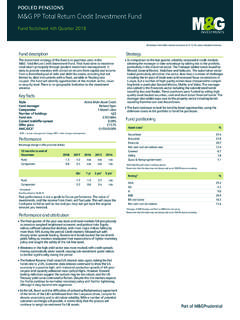Transcription of Return on Investment Analysis - Agile Insights
1 Return on Investment Analysis Mark Jeffery, Northwestern University Introduction The Information Paradox Review of Basic Finance The Time Value of Money ROI, Internal Rate of Return (IRR), and Payback Period Calculating ROI for a Technology Project Base Case Incorporating the Technology Project Incremental Cash Flows and IRR Uncertainty, Risk, and ROI Uncertainty Sensitivity Analysis Project and Technology Risks Monte Carlo Analysis Applied to ROI Executive Insights The Important Questions to Ask When Reviewing an ROI Analysis A Framework for Synchronizing Technology Investments with Corporate Strategy Beyond ROI.
2 Trends for the Future 2 2 ABSTRACT Return on Investment (ROI) Analysis is often an essential component of the management decision to invest in a new technology product or information technology (IT) project. This chapter reviews the basic concepts necessary for calculating ROI and applies these concepts to an example technology project. Research on ROI for corporate investments in IT is also reviewed. A case example illustrates how a technology project s cash flows, combined with the initial Investment , can be used to calculate the ROI.
3 The challenge in practice is to quantify the costs and benefits of the technology project. In addition, risk plays a significant role, because poor estimates and risk events are most often the drivers of poor ROI when technology projects are put into practice. Methods of incorporating uncertainty in assumptions and risk into an ROI Analysis are described. Finally, for the executive manager, important questions to ask when reviewing ROI Analysis are discussed, and the role of ROI Analysis in synchronizing technology investments with corporate strategy.
4 For Investment -strategy synchronization, technology portfolio management is reviewed. 3 INTRODUCTION New technology projects must often show a good Return on Investment (ROI) in order to be funded. This chapter will give the reader the key concepts necessary to understand and calculate ROI for technology projects. In addition, the limitations of calculating ROI, best practices for incorporating uncertainty and risk into ROI Analysis , and the role ROI plays in synchronizing technology investments with corporate strategy will be discussed.
5 What is ROI? One conceptual definition is that ROI is a project s net output (cost savings and/or new revenue that results from a project less the total project costs), divided by the project's total inputs (total costs), and expressed as a percentage. The inputs are all of the project costs such as hardware, software, programmers time, external consultants, and training. Therefore if a project has an ROI of 100%, from this definition the cash benefits out of the project will be twice as great as the original Investment .
6 (In the section Review of Basic Finance we will discuss how this definition of ROI, although qualitatively correct, does not accurately include the time value of money, and we will give a more accurate definition based upon internal rate of Return (IRR).) Should a manager invest a company's money in a technology project if it has a projected ROI of 100%? There are many factors one should consider when making an Investment decision. These factors include, but are not limited to those listed below: The assumptions underlying the costs of the project.
7 The assumptions underlying the potential benefits. The ability to measure and quantify the costs and benefits. The risk that the technology may not be fully developed. The risk that the project will not be completed on time and on budget and will not deliver the expected benefits. The strategic context of the firm; that is, does the project fit with the corporate strategy? The context of the project: that is, how does it fit within the portfolio of all technology investments made by the firm? The assumptions underlying the model and risks associated with the technology project are key drivers of uncertainty in any ROI Analysis .
8 Awareness of these uncertainties and the impact of risks on ROI can significantly improve the likelihood of successful Investment decisions. The Return on Investment for corporate information technology (IT) investments has been the subject of considerable research in the last decade. (For reviews see Brynjolfsson & Hitt, 1998; Dehning & Richardson, 2002; Strassmann, 1990.) The most recent research suggests that investing in IT does on average produce significant returns (Brynjolfsson & Hitt, 1996).
9 See the next section, The Information Paradox, for a discussion of this research. Jeffery and Leliveld (2004) surveyed CIOs of the Fortune 1000 companies: Of the 179 CIO respondents, 59% reported that their firms regularly calculated the ROI of IT projects prior to making an Investment decision, and 45% of respondents reported that ROI was an essential component of the decision-making process. ROI is therefore an important component of the information technology Investment decisions made in many large companies.
10 However, an interesting observation is that only 25% of companies responding to the survey actually measured the realized ROI after a project was complete. ROI Analysis is therefore primarily used to justify an Investment decision before the Investment is made. Performing post-project Analysis provides valuable feedback to the Investment decision process to verify the validity of the original ROI Analysis , and the feedback improves ROI calculations in the future. Feedback also enables the weeding out of underperforming projects.





